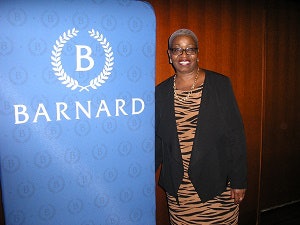As we approach the 100th anniversary of the 19th Amendment, African American studies specialist Dr. Marilyn Sanders Mobley says it’s time academia recognized the contribution of women of color in the Suffrage Movement.
This week, Mobley returned to her undergraduate alma mater, Barnard College, to present the lecture, “The Difference Intersectionality Makes: Teaching the Suffrage Movement Today.” It is possible, she said, to celebrate women fighting for and earning the right to vote while also criticizing the telling of this history.
Mobley, who is professor of English and African American studies at Case Western Reserve University (CWRU), mentioned the names of women who helped shape her thoughts on taking an intersectional approach to the teaching of the Suffrage Movement. She especially highlighted the work of influential legal scholar Kimberlé Crenshaw in establishing the concept of intersectionality.
 Dr. Marilyn Sanders Mobley
Dr. Marilyn Sanders MobleyMobley showed a video of the song “Four Women” performed by Lisa Simone, Dianne Reeves, Lizz Wright and Angélique Kidjo. “I shared this rendition of the Nina Simone song…because I wanted to begin with an example of what I call ‘both and’ thinking of the ways in which race is both an important category of identity and to call attention to the diversity within the category of Black women,” said Mobley, who from 2009–2019 served as the inaugural vice president for inclusion, diversity and equal opportunity at CWRU.
“The occasion of the 100th anniversary of the ratification of the 19th Amendment is an opportunity to remember … the ‘both and’ history of the Women’s Suffrage Movement,” said Mobley. “The Suffrage Movement was both about the right to vote for all women and it is an opportunity to remember the history of that same movement for the ways in which it exposed how women of color were often excluded from the narrative even as they were very much a part of the struggle.”
The proclivity to tell the story of suffrage from the perspective of Elizabeth Cady Stanton, Susan B. Anthony, Lucy Stone and other White women leaders of the movement does an injustice to the women of color who were part of it. Mobley said these women were simultaneously engaged in three levels of struggle —enslavement, racial violence and persistent injustice following abolition.
“I recently saw an example of this exclusion in the narrative when I when I went to the Women’s Suffrage Movement web page at the National Women’s History Museum website,” said Mobley. “As a Black woman, as a Black scholar and as an American citizen who has received three degrees in this country, I’ve been keenly aware of how other omissions and exclusions of people who look like me have contributed to the narrative, how it affects the larger American narrative that others are taught and believe.”
By contrast, the National Portrait Gallery at the Smithsonian is attempting to address this fraught history. How we tell the narrative of the Suffrage Movement matters to all Americans regardless of how we identify, said Mobley.
“How we tell this narrative, especially matters in our classrooms,” said Mobley. “It’s the space where I believe we have the opportunity and the responsibility to provide the evidence of how we have been co-workers in the struggle for suffrage, women’s rights, equity and social justice.”
The 2020 Women’s History Month theme is “Valiant Women of the Vote.” Mobley illustrated the difference intersectionality makes in teaching history and in informing our current political moment.
Sojourner Truth represents an example of the impact of intersectionality at an early moment of the Suffrage Movement. Truth gave a hugely influential speech at the women’s suffrage meeting in Akron, Ohio in 1851, even though the White women did not want her to speak.
“She used the platform of that meeting to give voice to the interlocking forms of oppression of racism and sexism with which she was all too familiar,” said Mobley. “There will always be those who attempt to appropriate our voice and our narrative for their own purposes.”
Mobley then discussed journalist and educator Ida B. Wells, who is best known for her anti-lynching campaign. “She was a literary activist who used the power of the pen at the intersection of race and gender for civil rights and the right to vote,” said Mobley.
In 1889, in coalition with other Black women, including Mary Church Terrell and Anna Julia Cooper, Wells founded the National Association of Colored Women. Wells organized one of the first suffrage groups for Black women, the Alpha Suffrage Club, in 1913. That same year Black women were forced to walk in the back of the procession at the National American Woman Suffrage Association suffrage parade.
“When we teach the Suffrage Movement today, we must look for inclusive stories of women who were excluded,” said Mobley. “The fact that White supremacy and racism tainted the movement must be told.
“The interlocking, sometimes contradictory histories flesh out a complex narrative that should inspire us to be curious enough to ask why, how and who,” she added. “That curiosity will inspire us to move beyond discussions of suffrage and the struggle for the vote from the past to the struggles for full citizenship that continue and are in public spaces today around the topic of indigenous people and immigration.”
Mobley also called for more research about Latinx, Asian and Native American women and the subsequent struggle for the vote that is part of their history in America.
“Our curriculum and our pedagogy around the women’s movement of the past and present must account for these interlocking systems and identify an identity related to ethnicity, race, gender, sexual orientation, identity expression, ability, religion, age, language, immigration status and nation of origin,” she said.
“When we do not acknowledge, address, teach or discuss we collude in perpetuating silence, ignorant stereotypes,” Mobley said. “We know now more than ever that our vote is not in a vacuum.”





















